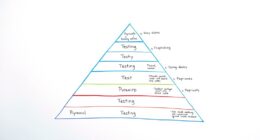Chaos experiments measure your system’s resilience by intentionally introducing faults through fault injection and monitoring key metrics like recovery time, failure rate, and uptime. This process helps you see how well your system withstands unexpected failures and adapt under stress. By analyzing these resilience metrics, you can identify weaknesses and strengthen your system for better stability. Keep exploring to discover how these insights can optimize your system’s robustness even further.
Key Takeaways
- Use fault injection to simulate specific failures and observe how the system responds under stress.
- Measure resilience through metrics like recovery time, failure rate, and system uptime during chaos experiments.
- Analyze system degradation levels to determine if it degrades gracefully or crashes entirely.
- Continuous monitoring during chaos tests provides real-time insights into system robustness and weak points.
- Quantitative metrics help prioritize improvements and strengthen system resilience against unexpected disruptions.

Chaos experiments are deliberate tests designed to introduce controlled disruptions into complex systems, revealing their weaknesses and improving overall resilience. When you perform these experiments, you’re essentially probing your system’s ability to withstand unexpected failures. Fault injection plays a pivotal role here, allowing you to simulate specific faults such as server crashes, network delays, or data corruption. By intentionally injecting faults, you can observe how your system responds and whether it maintains its fundamental functions. This process helps identify vulnerabilities that might not be apparent during normal operations.
Chaos experiments deliberately introduce controlled failures to test system resilience and uncover hidden vulnerabilities.
As you carry out chaos experiments, measuring resilience becomes indispensable. Resilience metrics provide quantifiable insights into how well your system can adapt to disruptions. These metrics can include recovery time, failure rate, system uptime during faults, and the extent of degradation under stress. Tracking these indicators helps you understand the system’s robustness and pinpoint areas that need reinforcement. For example, a high recovery time may indicate that your system needs better failover strategies or more efficient error handling mechanisms.
Incorporating fault injection into your chaos experiments isn’t just about causing failures; it’s about learning how your system behaves under stress. You want to see if it gracefully degrades or crashes completely. Monitoring resilience metrics during these tests allows you to assess your system’s resilience in real-time. If certain faults cause catastrophic failures, you can focus on strengthening those weak points. Conversely, if your system handles faults gracefully, you can consider your resilience metrics satisfactory, but always look for opportunities to improve.
You should also consider how different types of faults impact your resilience metrics. For instance, injecting network latency might reveal how well your system manages slow connections, while data corruption tests your error detection and correction capabilities. By systematically varying fault types and intensities, you gather extensive data on your system’s resilience profile. This data-driven approach enables you to prioritize improvements based on actual performance under stress. Additionally, understanding the importance of high-quality components can contribute to building a more resilient system overall.
Ultimately, chaos experiments aren’t just about breaking things—they’re about building better, more resilient systems. Using fault injection combined with resilience metrics, you gain clear insights into your system’s strengths and weaknesses. This knowledge empowers you to make informed decisions, implement necessary improvements, and guarantee your system can withstand the unpredictable challenges of real-world operation. Through continuous testing and measurement, you strengthen your system’s resilience, making it more reliable and robust over time.
Frequently Asked Questions
How Do Chaos Experiments Improve Long-Term System Stability?
Chaos experiments help you improve long-term system stability by testing fault tolerance under real-world conditions. By intentionally introducing failures, you identify weaknesses and validate resilience metrics, ensuring your system can withstand unexpected disruptions. This proactive approach allows you to refine your infrastructure, reduce downtime, and build a more resilient environment. Over time, these experiments empower you to anticipate issues earlier and maintain a robust, reliable system.
What Are Common Pitfalls When Designing Chaos Experiments?
Did you know that 60% of organizations struggle with designing effective chaos experiments? When planning fault injection tests, you might overlook clear objectives, making it hard to interpret results. Common pitfalls include neglecting hypothesis testing, which leads to ambiguous data. Also, overloading systems or not simulating real-world conditions can skew outcomes. To succeed, define precise goals, test hypotheses carefully, and mimic actual production environments for accurate insights.
How Do You Ensure Safety During Chaos Testing?
When it comes to chaos testing, you guarantee safety by implementing strict safety protocols and risk mitigation strategies. You start with thorough planning, clearly defining the scope and limits of experiments. You also set up monitoring tools to track system behavior in real-time, ready to halt tests if issues arise. Regularly communicate with your team and document procedures so everyone understands how to respond swiftly, minimizing potential disruptions.
What Tools Are Most Effective for Chaos Experimentation?
When exploring tools for chaos experimentation, focus on those that enable fault injection and provide clear resilience metrics. You want tools like Chaos Monkey or Gremlin, which let you introduce controlled failures and observe how your system responds. These tools help you identify weaknesses and improve resilience, ensuring your system can withstand real disruptions. By measuring resilience metrics, you gain insights into the effectiveness of your chaos experiments and overall system robustness.
Can Chaos Experiments Be Applied to Non-It Systems?
Imagine testing the strength of a delicate bridge or the stability of a power grid—chaos experiments aren’t limited to digital worlds. You can apply them to non-IT systems and physical infrastructure, pushing boundaries to reveal vulnerabilities. By introducing controlled disruptions, you uncover hidden weaknesses, ensuring resilience. So, yes, chaos experiments can indeed be adapted, helping you safeguard everything from bridges to manufacturing lines with the same precision and insight.
Conclusion
As you run chaos experiments, you’re like a storm chaser, testing the skies to see how your system weather’s the tempest. Each disruption is a lightning bolt, revealing cracks and strengths beneath the surface. By measuring resilience, you’re planting seeds that grow into sturdy oaks amid the chaos. Remember, resilience isn’t just a shield—it’s the river carving its path through rocky terrain, shaping a system that bends without breaking, ready for whatever storms may come.
Randy serves as our Software Quality Assurance Expert, bringing to the table a rich tapestry of industry experiences gathered over 15 years with various renowned tech companies. His deep understanding of the intricate aspects and the evolving challenges in SQA is unparalleled. At EarnQA, Randy’s contributions extend well beyond developing courses; he is a mentor to students and a leader of webinars, sharing valuable insights and hands-on experiences that greatly enhance our educational programs.









